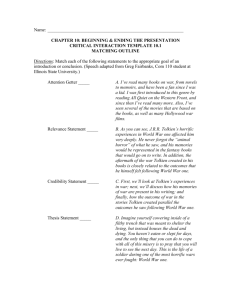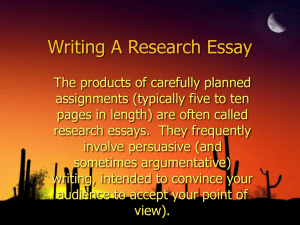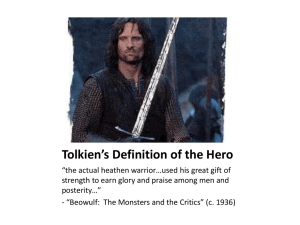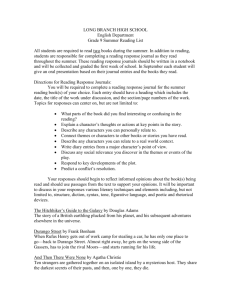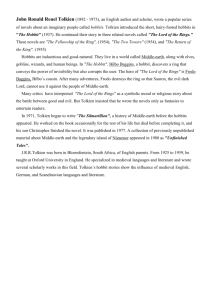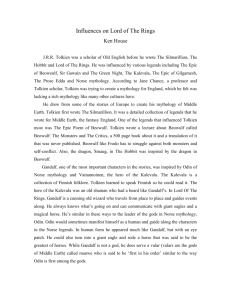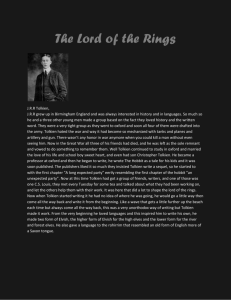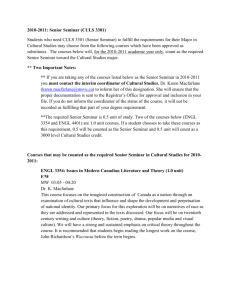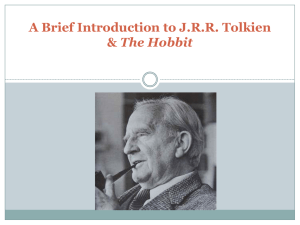Chance, Jane (ed). Tolkien and the Invention of
advertisement
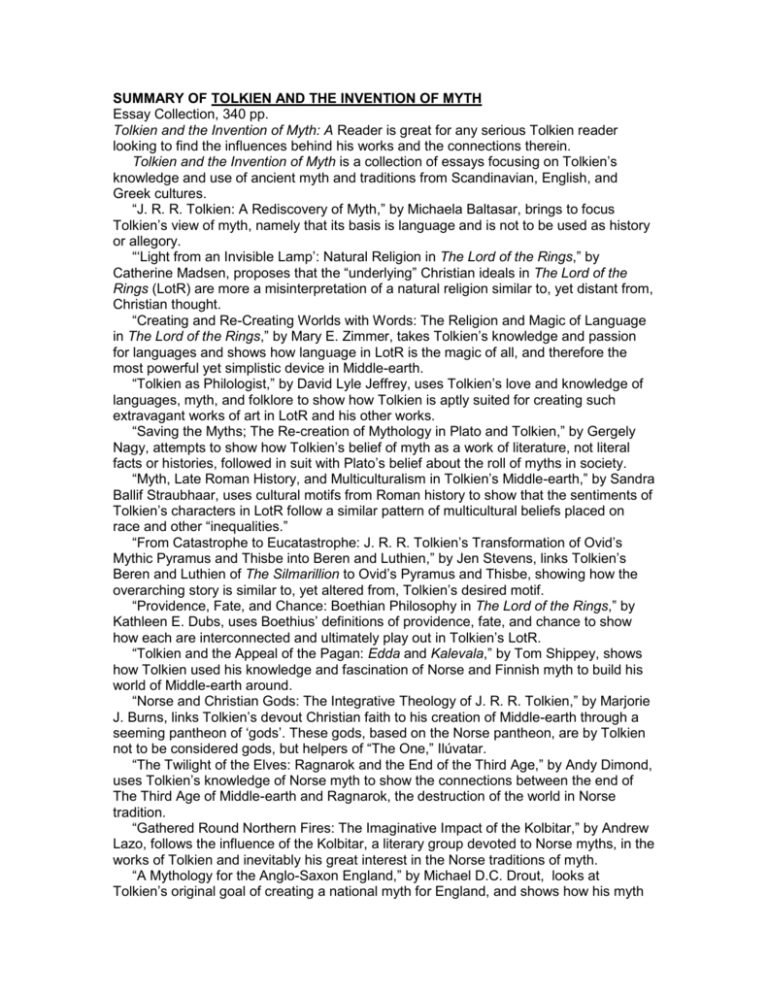
SUMMARY OF TOLKIEN AND THE INVENTION OF MYTH Essay Collection, 340 pp. Tolkien and the Invention of Myth: A Reader is great for any serious Tolkien reader looking to find the influences behind his works and the connections therein. Tolkien and the Invention of Myth is a collection of essays focusing on Tolkien’s knowledge and use of ancient myth and traditions from Scandinavian, English, and Greek cultures. “J. R. R. Tolkien: A Rediscovery of Myth,” by Michaela Baltasar, brings to focus Tolkien’s view of myth, namely that its basis is language and is not to be used as history or allegory. “‘Light from an Invisible Lamp’: Natural Religion in The Lord of the Rings,” by Catherine Madsen, proposes that the “underlying” Christian ideals in The Lord of the Rings (LotR) are more a misinterpretation of a natural religion similar to, yet distant from, Christian thought. “Creating and Re-Creating Worlds with Words: The Religion and Magic of Language in The Lord of the Rings,” by Mary E. Zimmer, takes Tolkien’s knowledge and passion for languages and shows how language in LotR is the magic of all, and therefore the most powerful yet simplistic device in Middle-earth. “Tolkien as Philologist,” by David Lyle Jeffrey, uses Tolkien’s love and knowledge of languages, myth, and folklore to show how Tolkien is aptly suited for creating such extravagant works of art in LotR and his other works. “Saving the Myths; The Re-creation of Mythology in Plato and Tolkien,” by Gergely Nagy, attempts to show how Tolkien’s belief of myth as a work of literature, not literal facts or histories, followed in suit with Plato’s belief about the roll of myths in society. “Myth, Late Roman History, and Multiculturalism in Tolkien’s Middle-earth,” by Sandra Ballif Straubhaar, uses cultural motifs from Roman history to show that the sentiments of Tolkien’s characters in LotR follow a similar pattern of multicultural beliefs placed on race and other “inequalities.” “From Catastrophe to Eucatastrophe: J. R. R. Tolkien’s Transformation of Ovid’s Mythic Pyramus and Thisbe into Beren and Luthien,” by Jen Stevens, links Tolkien’s Beren and Luthien of The Silmarillion to Ovid’s Pyramus and Thisbe, showing how the overarching story is similar to, yet altered from, Tolkien’s desired motif. “Providence, Fate, and Chance: Boethian Philosophy in The Lord of the Rings,” by Kathleen E. Dubs, uses Boethius’ definitions of providence, fate, and chance to show how each are interconnected and ultimately play out in Tolkien’s LotR. “Tolkien and the Appeal of the Pagan: Edda and Kalevala,” by Tom Shippey, shows how Tolkien used his knowledge and fascination of Norse and Finnish myth to build his world of Middle-earth around. “Norse and Christian Gods: The Integrative Theology of J. R. R. Tolkien,” by Marjorie J. Burns, links Tolkien’s devout Christian faith to his creation of Middle-earth through a seeming pantheon of ‘gods’. These gods, based on the Norse pantheon, are by Tolkien not to be considered gods, but helpers of “The One,” Ilúvatar. “The Twilight of the Elves: Ragnarok and the End of the Third Age,” by Andy Dimond, uses Tolkien’s knowledge of Norse myth to show the connections between the end of The Third Age of Middle-earth and Ragnarok, the destruction of the world in Norse tradition. “Gathered Round Northern Fires: The Imaginative Impact of the Kolbitar,” by Andrew Lazo, follows the influence of the Kolbitar, a literary group devoted to Norse myths, in the works of Tolkien and inevitably his great interest in the Norse traditions of myth. “A Mythology for the Anglo-Saxon England,” by Michael D.C. Drout, looks at Tolkien’s original goal of creating a national myth for England, and shows how his myth became that of Anglo-Saxon prehistory, and its influences in his works; namely that of The History of Middle-earth. “Oaths and Oath Breaking: Analogues of Old English Comitatus in Tolkien’s Myth,” by John R. Holmes, uses the traditional old English practices, which follow a strict code of Oaths, to show the importance of oaths and oath breaking in LotR. “‘On the Borders of Old Stories’: Enacting the Past in Beowulf and The Lord of the Rings,” by Alexandra Bolintineanu, shows how the past histories of both Beowulf and Tolkien’s LotR run parallel to the present in both worlds through language and other allusions by characters. “A Mythology for Finland: Tolkien and Lonnrot as Mythmakers,” by Verlyn Flieger, makes connections between Lonnrot’s Kalevala and Tolkien’s works. The importance of a national myth to Tolkien can be seen as directly related to Lonnrot and his accomplishment with the Kalevala. “Setting the Rocket Off in Story: The Kalevala as the Germ of Tolkien’s Legendarium,” by Richard C. West, shows the connection between The Kalevala and Tolkien’s Legendarium; more specifically, similarities can be seen in the tales of Turin and Beren of The Silmarillion. “J. R. R. Tolkien and the Kalevala: Some Thoughts on the Finnish Origins of Tom Bombadil and Treebeard,” by David Elton Gay, makes the direct connection of Lonnrot’s character Vainamoinen and the characters of Bombadil and Treebeard based on their use of knowledge of the world, and more specifically, the connection of the powers of song with Vainamoinen and Bombadil. EVALUATION OF TOLKIEN AND THE INVENTION OF MYTH Tolkien and the Invention of Myth: A Reader ranges from great to excellent. The biggest problem that one should have with this book is the complete diversity of essays. Ranging from linguistic studies to character development and comparisons to ancient myth, this collection runs the gamut of all that seems to be important to Tolkien’s work. An inevitable weakness that follows is a lack of depth to the individual pieces. Each essay could have an entire book devoted to the subject, yet each author is restricted to a few pages, limiting the amount of information and in some cases the clarity of the subject as a whole. As a sampler, this collection is of high quality. Each essay is well written; clear and to the point. As stated above, the lack of room can leave one wanting, but with an interest in the subject and a drive for knowledge one could easily find a book of more depth on any of the subjects. The range of this collection works wonders in enticing the reader to have this drive. The five sections which this collection is divided into can help bring a greater understanding to what each author was attempting to do, as most essays build off of the previous essay in some manner. The greatest strength of this collection is just that; the number of essays. Each essay is so well written that when the following essay builds of the previous, the reader can easily understand, and even combine the knowledge of the two essays to create a greater overall picture of Tolkien’s world. Specifically, Shippey’s piece on the Edda and Kalevala show superior research and style. The connections made to Tolkien’s mythology and that of old Norse and Finnish are without a doubt important and thought provoking in any reader’s mind. As a whole, this is a great collection of essays which – for any reader wanting to go deeper into the scholarly aspect of Tolkien’s works, namely the history behind his writings and his drive to create his Legendarium – opens the doors to a deeper world of scholarly work on Tolkien’s creations. HIGHLIGHTS OF TOLKIEN AND THE INVENTION OF MYTH Two sections of this collection stood out more than the rest; the section on Norse myths and the section on Finnish myths. Though Tolkien was attempting to create a national myth for the English, his greatest influences come from these two northern European people groups. The strength of the essays in these two sections is astounding, as their sources are nearly as endless as they are deep. The connections made to the Norse pantheon and Christian “gods” in Marjorie Burns’s essay are of great quality. The combination of Tolkien’s faith and his love of the pantheon of gods in Norse mythology was something I was unaware of, yet the essays clearly defined the separation and inclusion of these two juxtaposed views. As for David Elton Gay’s essay on the relation to Lonnrot’s character and Bombadil, I found nothing more amusing yet perfectly matched. The characters are almost identical in their own right, yet they are each of their own creation. To see the influences of other great mythical works on Tolkien and find how he mastered them and developed his own myths with these influences is beyond simply good. Tolkien is shown through these essays to be a master of his art, to be a master of his lore, and to be a master of the lore that surrounds him. Knowing his influences, the history in his work is nothing more than amazing for any serious reader of Tolkien.
